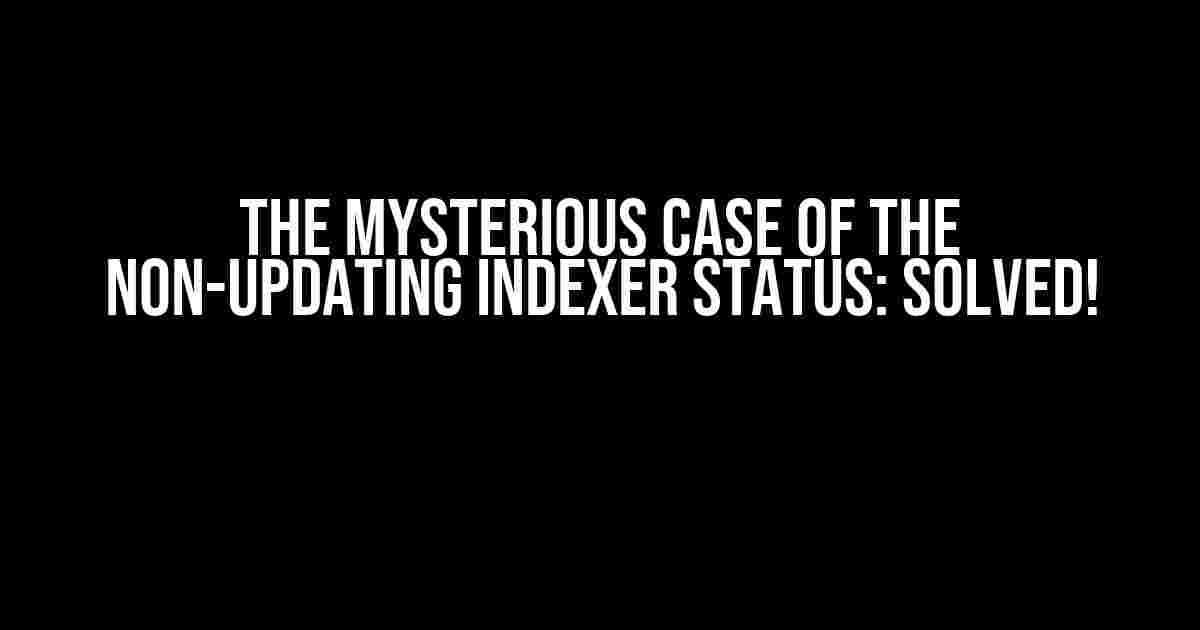Are you tired of staring at a stagnant indexer status, wondering why it’s not updating despite your best efforts? You’re not alone! This frustrating issue has plagued many developers and data enthusiasts, leaving them feeling helpless and confused. Fear not, dear reader, for we’re about to delve into the depths of this problem and emerge victorious, with a comprehensive guide to resolve the “Indexer status is not updating while running” conundrum.
Understanding the Indexer Status
To tackle this issue, it’s essential to grasp the fundamental concept of the indexer status. The indexer is a crucial component of various data processing systems, responsible for creating and maintaining indexes of data. The status of the indexer indicates its current state, providing valuable insights into its performance and health.
When the indexer status is stuck or not updating, it can lead to a range of issues, including:
- Delayed data processing
- Inaccurate query results
- Data inconsistencies
- System crashes or freezes
Causes of a Non-Updating Indexer Status
Before we dive into the solutions, let’s identify the common culprits behind this issue:
- Incorrect configuration: Misconfigured indexer settings or parameters can cause the status to stuck or not update.
- Resource constraints: Insufficient system resources, such as CPU, memory, or disk space, can hinder the indexer’s ability to update its status.
- Data inconsistencies: Inconsistent or corrupted data can prevent the indexer from updating its status accurately.
- Network connectivity issues: Poor network connectivity or server-side errors can disrupt the indexer’s ability to communicate its status.
- Indexer overload: An overwhelmed indexer can struggle to update its status, leading to stagnation.
Troubleshooting and Solutions
Now that we’ve covered the causes, let’s get to the good stuff – the solutions!
1. Verify Configuration Settings
Double-check your indexer configuration settings to ensure they’re correct and up-to-date. Review the following:
{
"indexer": {
"enabled": true,
"interval": 300,
"timeout": 1000
}
}
In the example above, make sure the `enabled` property is set to `true`, and the `interval` and `timeout` values are reasonable for your system.
2. Monitor System Resources
Ensure your system has sufficient resources to support the indexer. Check:
- CPU usage: Aim for < 80% utilization
- Memory usage: Ensure at least 20% free memory
- Disk space: Verify there’s enough free disk space for the indexer to operate
If resource constraints are an issue, consider scaling up your system or optimizing your indexer configuration.
3. Data Consistency and Integrity
Ensure your data is accurate, consistent, and free from corruption. Perform the following checks:
- Run data validation scripts to detect inconsistencies
- Check for data duplication or redundancy
- Verify data formatting and schema adherence
If data issues are detected, rectify them and re-run the indexer.
4. Network Connectivity and Server-Side Errors
Verify network connectivity and server-side errors using tools like:
- Ping or traceroute commands to test network connectivity
- Server logs to identify error messages or warnings
Resolve any network or server-side issues that may be hindering the indexer’s ability to update its status.
5. Indexer Overload Prevention
To prevent indexer overload, implement the following strategies:
- Use data sampling or incremental indexing
- Optimize indexer configuration for performance
- Implement queuing or buffering mechanisms
Additional Tips and Best Practices
To ensure a healthy and updating indexer status, follow these best practices:
| Tips | Description |
|---|---|
| Regularly monitor indexer performance | Track key performance indicators like indexing speed, memory usage, and error rates. |
| Implement indexing quotas and limits | Prevent indexer overload by setting quotas and limits on data processing and indexing. |
| Use data compression and encoding | Reduce data size and improve indexing efficiency using techniques like compression and encoding. |
| Schedule indexer maintenance | Regularly schedule maintenance tasks, such as re-indexing or data cleanup, to ensure optimal indexer performance. |
By following these tips and best practices, you’ll be well on your way to maintaining a healthy and updating indexer status.
Conclusion
The “Indexer status is not updating while running” issue can be frustrating, but with this comprehensive guide, you’re now equipped to tackle the problem head-on. Remember to verify configuration settings, monitor system resources, ensure data consistency, troubleshoot network connectivity, and prevent indexer overload. By following these steps and adopting best practices, you’ll be able to resolve this issue and ensure your indexer status updates smoothly and efficiently.
Happy indexing, and may your data always be accurate and up-to-date!
Frequently Asked Question
Are you stuck with an indexer status that refuses to update while running? Don’t worry, we’ve got you covered! Here are some commonly asked questions and their answers to help you troubleshoot the issue.
Q1: Why is my indexer status not updating while running?
This might be due to a communication issue between your indexer and the server. Ensure that your indexer is properly connected to the server and that there are no firewall or network connectivity issues blocking the communication.
Q2: Is it possible that my indexer is not configured correctly?
Yes, that’s possible! Double-check your indexer configuration to ensure that it is set up correctly. Verify that the correct server URL, username, and password are entered. Also, make sure that the indexer is configured to update the status regularly.
Q3: Could a high CPU usage be causing the issue?
High CPU usage can indeed cause issues with indexer status updates. Check your system’s CPU usage and ensure that it’s not overloaded. You can also try to optimize your system’s resources or reduce the indexer’s resource usage to resolve the issue.
Q4: Is it possible that my indexer is stuck in an infinite loop?
Yes, that’s possible! If your indexer is stuck in an infinite loop, it might not be able to update the status. Try restarting the indexer or checking the indexer logs to identify any potential issues causing the loop.
Q5: What if none of the above solutions work?
If none of the above solutions work, it’s possible that there’s a deeper issue with your indexer or server. Consider reaching out to your system administrator or the indexer developer for further assistance. They can help you troubleshoot the issue and provide a more specific solution.



